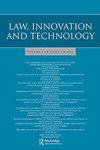Digisprudence: the design of legitimate code
Q1 Social Sciences
引用次数: 7
Abstract
ABSTRACT This article introduces digisprudence, a theory about the legitimacy of software that both conceptualises regulative code’s potential illegitimacies and suggests concrete ways to ameliorate them. First, it develops the notion of computational legalism – code’s ruleishness, opacity, immediacy, immutability, pervasiveness, and private production – before sketching how it is that code regulates, according to design theory and the philosophy of technology. These ideas are synthesised into a framework of digisprudential affordances, which are translations of legitimacy requirements derived from legal philosophy into the conceptual language of design. The ex ante focus on code’s production is pivotal, in turn suggesting a guiding ‘constitutional’ role for design processes. The article includes a case study on blockchain applications and concludes by setting out some avenues for future work.不谨慎:合法代码的设计
本文介绍了disprudence,这是一种关于软件合法性的理论,它既概念化了监管代码的潜在非法性,又提出了改善这些非法性的具体方法。首先,它发展了计算法律主义的概念——代码的规则性、不透明性、即时性、不可变性、普遍性和私人生产——然后根据设计理论和技术哲学概述了代码是如何调节的。这些想法被综合成一个数字审慎启示的框架,这是从法律哲学衍生的合法性要求转化为设计的概念语言。事前对代码生成的关注是关键的,反过来又暗示了设计过程的指导“宪法”作用。本文包括一个关于区块链应用程序的案例研究,并通过提出未来工作的一些途径来结束本文。
本文章由计算机程序翻译,如有差异,请以英文原文为准。
求助全文
约1分钟内获得全文
求助全文
来源期刊

Law, Innovation and Technology
Social Sciences-Law
CiteScore
4.50
自引率
0.00%
发文量
18
期刊介绍:
Stem cell research, cloning, GMOs ... How do regulations affect such emerging technologies? What impact do new technologies have on law? And can we rely on technology itself as a regulatory tool? The meeting of law and technology is rapidly becoming an increasingly significant (and controversial) topic. Law, Innovation and Technology is, however, the only journal to engage fully with it, setting an innovative and distinctive agenda for lawyers, ethicists and policy makers. Spanning ICTs, biotechnologies, nanotechnologies, neurotechnologies, robotics and AI, it offers a unique forum for the highest level of reflection on this essential area.
 求助内容:
求助内容: 应助结果提醒方式:
应助结果提醒方式:


